Abit was a motherboard manufacturer for the IBM PC and its compatibles during the DOS era. Their motherboards were popular among the overclocking community, and in the late 90s became the first manufacturer to have a fully jumperless CPU configuration fully controlled via their Softmenu feature in the BIOS. This was later extended with the introduction of the μGuru chip - only found on ABIT motherboards, it allowed for realtime overclocking while the operating system was running.
ABIT were also the first motherboard manufacturer to cater for 133 MHz FSB on the Intel 440BX chipset, on their AB-BX133 motherboard in 2000..
Founded in 1989 and headquartered in Taipei, Taiwan, they went through some financial difficulties in the early 2000s before being bought by a company called USI, where the motherboard side of the business was rebranded "Universal abit". They eventually wound down the motherboard business in 2009.
AB-AG4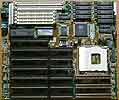
Year: 1993(?)
Type: Socket 2
Form Factor: Baby AT (260mm x 220mm)
Chipset: SiS 85C471
Slots: 7 x ISA (1 x 8-bit, 6 x 16-bit), 3 x VLB.
Memory: 4 x 30-pin SIMM, 2 x 72-pin SIMM (max 128 MB)
BIOS: AMI or Award
BIOS Strings: 40-01EE-001247-00101111-080893-SIS471B-F
Known Revisions:
The AB-AG4 from Abit supported 486SX/DX/DX2, the 80487SX and Pentium Overdrive from Intel, plus Cyrix' CX486SX/DX and S25/S33/S40 "FasCache" processors. Clock speeds supported go from 20 MHz up to 50 MHz. Clock-tripled DX4s are not supported.
Level 2 cache ranged from 128 KB up to 512 KB. Tag RAM chips can be either 8 KB (if 128 KB L2 cache is installed) or 32 KB for anything larger.
Main memory is split into three banks, with the four 30-pin SIMM slots making up Bank 0. This supports 256x8, 1MBx8, 4MBx8 and even 16MBx8 30-pin SIMMs, allowing up to 96 MB just from the use of this one bank. Banks 1 and 2 are the 72-pin SIMM slots, and accept only Fast Page Mode (FPM) SIMMs, not the later EDO.
Like most VESA Local Bus motherboards, you can set a jumper to switch between 0 and 1 wait state, and a second jumper to tell the board whether your CPU is running below 33 MHz or above - this will no doubt impact the frequency at which the local bus runs.
|
AB-AN4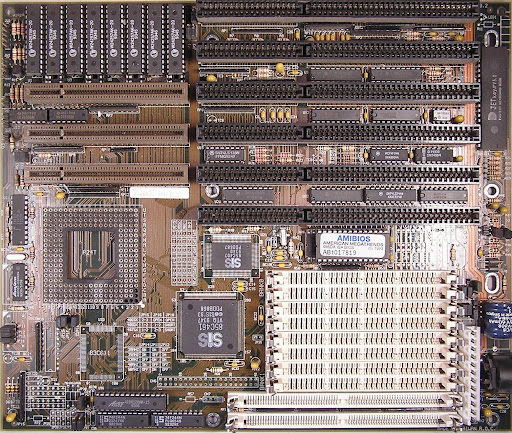
Year: 1993
Type: Socket 2
Form Factor: Baby AT (260mm x 220mm)
Chipset: SiS 461/407
Slots: 6 x ISA (16-bit), 3 x VLB
Memory: 8 x 30-pin SIMM, 2 x 72-pin SIMM (max. 64 MB)
BIOS:
BIOS Strings:
40-01CI-001247-00101111-080893-SIS461-H
Known Board Revisions: 0.2
The AN4 supports Intel 80486 SX, DX, and DX2 CPUs from 25 MHz up to 66 MHz, and Pentium OverDrive. Maximum FSB speed is 66 MHz.
L2 cache sizes are 128 KB, 256KB and 512 KB. |
AB-AR5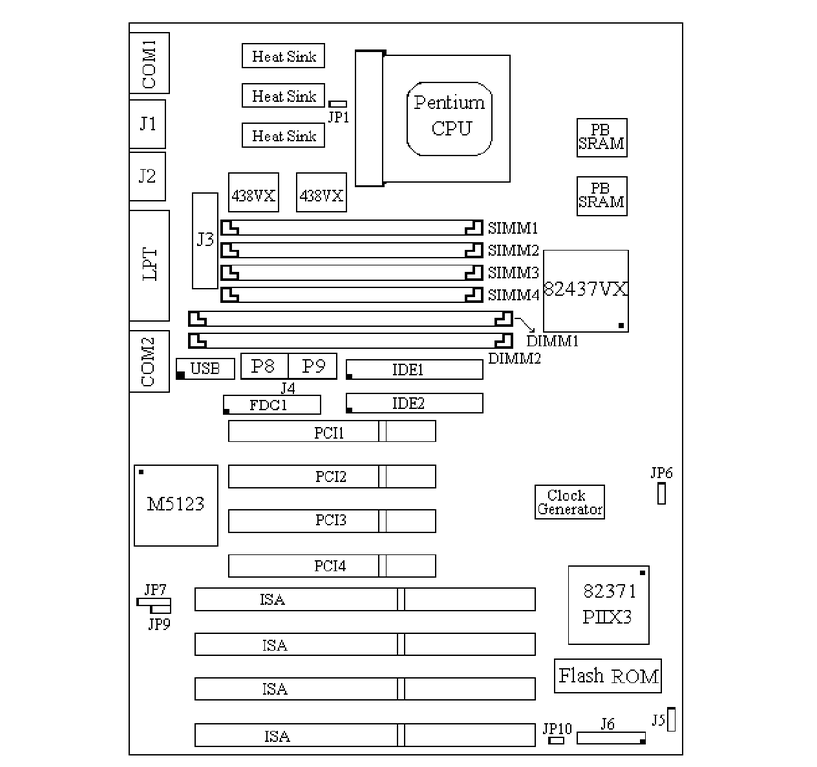
Year: 1996
Type: Socket 7
Form Factor:
Chipset: Intel 430VX Triton II
Slots: 4 x ISA (16-bit), 4 x PCI.
Memory: 4 x 72-pin SIMM (2 banks), 2 x 168-pin DIMM, 128 MB max.
BIOS: Award 4.51PG
Supports Intel Pentium P54C and P55C (MMX) CPUs, as well as AMD K5 and Cyrix 6x86. The board uses "Soft Menu", allowing all configurations to be done via the BIOS (no DIP switches or jumpers).
CPU Speeds supported from 75 - 200 MHz (Pentium), 75 - 100 MHz (AMD), and 6th gen Cyrix 6x86 (P120+, P133+, P150+, P166+, and P200+).
User Manual
|
AB-AX5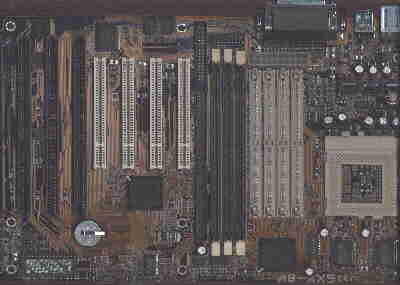
Year: 1998
Type: Socket 7
Form Factor: ATX
Chipset: Intel 430TX
Slots: 3 x ISA (16-bit), 4 x PCI
Memory: 4 x 72-pin SIMM (2 banks), 3 x DIMM.
BIOS: Award
Known Revisions:
2.2
Comes with 512KB pipeline burst L2 cache onboard. Bus frequencies from 50 up to 83 MHz. CPU core voltage support is 3.2V, 2.9V, 2.8V, 2.7V and 2.5V, with clock multipliers from 1.5x up to 3.5x. The board is jumperless so no CPU configuration is required via jumpers.
Memory of EDO and SDRAM 3.3V are supported.
Some revisions have 4 x ISA slots and 4 x PCI slots.
You cannot disable the USB interrupt on this board.
From Tom's Hardware review:
"At 83 MHz, this board is one of the fastest, at normal bus speeds it is better than average. This board features ’Soft Menu ’, it’s an extension to the Award BIOS 4.51PG, which allows to set the CPU and bus frequencies in the system BIOS. This seems to be made for playing with the different possibilities. Let run your favorite application or OS with 75 or in some cases 83 MHz system bus speed, and write your recordable CDs at safe 66 MHz. Without opening your case, isn’t it great ? As in the prior socket 7 review already mentioned, this board has some difficulties with certain types of SDRAM, e.g. the older Corsair modules won’t work properly. If you are looking for an ATX board to run at the highest possible external clock speed, think about the AX5."
"This motherboard certainly keeps up to Abit's high standards, but doesn't seem to quite keep up with their TX5 model. The motherboard offers all of Abit's usual added extras like CPU configuration through the BIOS and voltage monitoring. There is also a feature within the BIOS to change the CPU core and I/O voltages manually. Although this can aid in setting up a system it could also potentially damage your CPU if set to a too high a voltage. To Abit's credit this feature is only available when the CPU configuration is set to manual, so for general motherboard setup this shouldn't pose a problem. A piece of electronics certainly worth a look if you are in the market for a Socket 7 motherboard.
Mainboard Design: 95
Speed: 90
Features: 92
Overclockability: 95
OVERALL: 93"
PC PowerPlay, July 1998
|
AB-BH6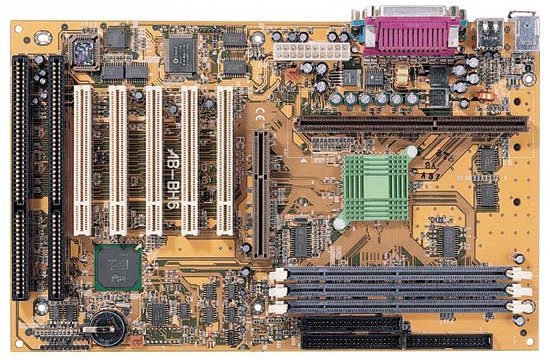
Year: 1998
Type: Slot 1
Form Factor: ATX
Chipset: Intel 440BX (Seattle)
Slots: 2 x ISA (16-bit), 5 x PCI, 1 x AGP 2x
Memory: 3 x 168-pin DIMM supporting SDRAMs of PC-66 or PC-100. It supports parity and ECC RAM.
BIOS: Award Modular BIOS v4.51PG
Known Revisions:
1.02
Suitable for Pentium II (Klamath and Deschutes), Pentium III (Katmai and Coppermine*), and Celeron (Covington, Mendocino, and Coppermine*)
*Coppermines over 700 MHz only from with BH6 v1.1 or v1.2.
The BH6 supports front side bus speeds from 66, 75, 83, 100, 103, 112, 124 and 133 MHz. It supports CPU clock multipliers of 2.0x through to 5.5x, and CPU voltage ranges from 1.30V up to 3.2V in 0.1V or 0.05V increments.
It's a jumperless setup, thankfully, due to Abit's SoftMenu II.
|
AB-BX6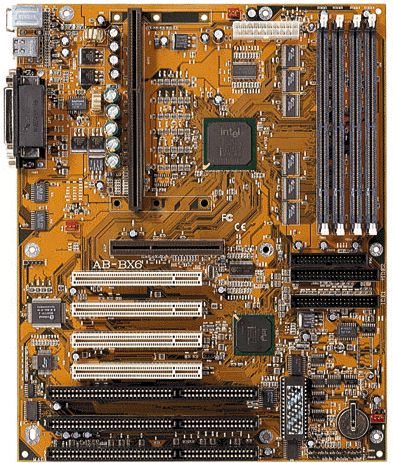
Year: Spring 1998
Type: Slot 1
Form Factor: ATX
Chipset: Intel 440BX (Seattle)
Slots: 3 x ISA (16-bit), 4 x PCI, 1 x AGP 2x
Memory: 4 x 168-pin DIMM supporting SDRAMs of PC-66 or PC-100.
BIOS: Award Modular BIOS v4.51PG
The BX6 was ABit's successor to the LX6, which had problems with many PCI and ISA cards, plus a serious keyboard problem. Unlike most other boards out around this time, this one doesn't come with the SBLink header.
If you have issues with ISA network cards on this motherboard, make sure you're running the latest BIOS version as there were compatibility issues in earlier versions.
You can select FSB speed from 66 up to 133 MHz under the 'CPU SoftMenu' BIOS (ABit actually call this SoftMenu II) option. Under here you can also choose the CPU core voltage. All in all, it's a good board for overclockers, despite the lack of any RAM timing options in the BIOS.
|
AB-IT5H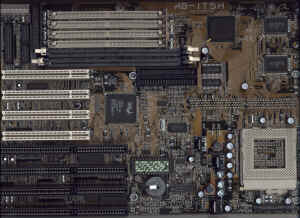
Year: 1997
Type: Socket 7
Form Factor: AT
Chipset: Intel 430HX
Slots: 4 x ISA (16-bit), 4 x PCI
Memory: 4 x 72-pin SIMMs, 2 x 168-pin SIMMs (both support EDO and FP DRAM). Also has 512 KB built-in SRAM. Maximum memory supported is 512 MB.
Known Revisions: 1.5, 2.0
Supports Pentium and Pentium MMX, AMD K5 and K6, Cyrix 6x86, 6x86MX PR150-PR200 processors. Core voltage support for 3.2V, 2.9V, 2.8V and 2.7V. The board has two TAG RAMs to support a cacheable area of up to 512 MB.
FSB speeds range from 50 MHz up to 83 MHz.
Does not support the AMD K6-2+ or K6-III+ due to the lack of a low enough voltage selection. This of all boards months ago was the first running perfectly even at 83 MHz bus speed. By the way, the memory timings were all switched to 'maximum warp' without errors. This means quite good performance under Windows 95; Windows NT is a bit slower, also the usage of a 6x86MX CPU. But its performance is comparable to some boards with the 430TX chipset! The latest revision 2.0 now has switching regulators; if you should own a IT5H, don't think about upgrading to a TX chipset board, you probably won't get much more performance, especially in case you're using over 64 MB RAM.
|
AB-PH5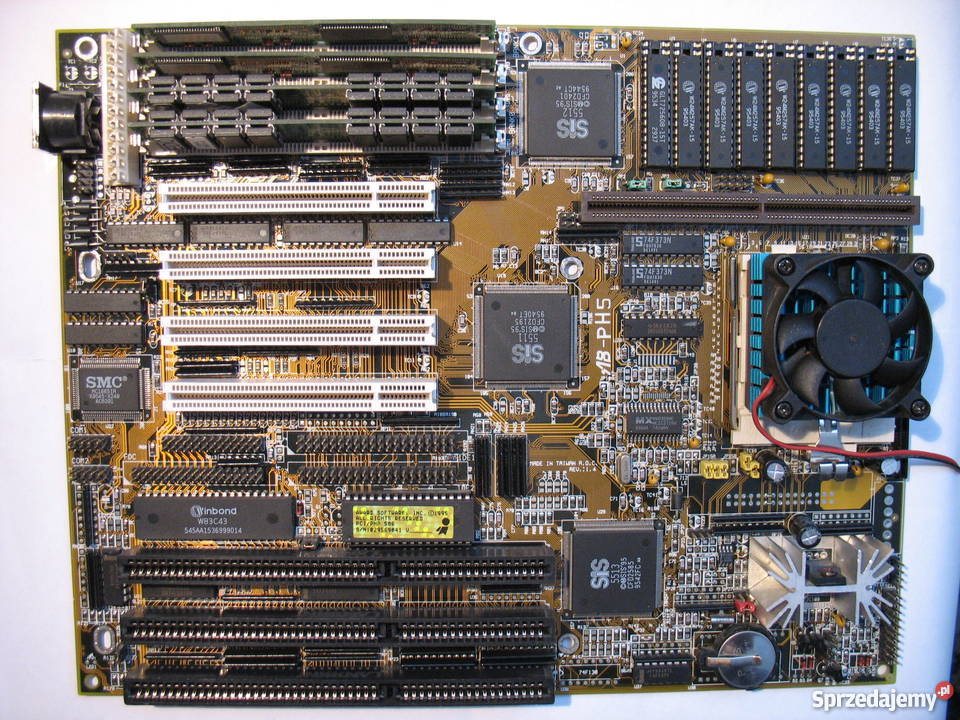
Year: 1995?
Type: Socket 7
Form Factor: AT
Chipset: SiS 5511/5512
Slots: 3 x ISA (16-bit), 4 x PCI
Memory: 4 x 72-pin SIMMs
BIOS: Award
BIOS Dates: 12/08/95
Known Board Revisions: 1.1, 1.3
Supports Cyrix 6x86 CPUs. Must have Sync L2 set, and Linear Burst mode. Supports up to 128 MB of RAM. Cache sizes available are 256 KB and 512 KB.
Click here for more configuration info for this motherboard.
|
AB-PN5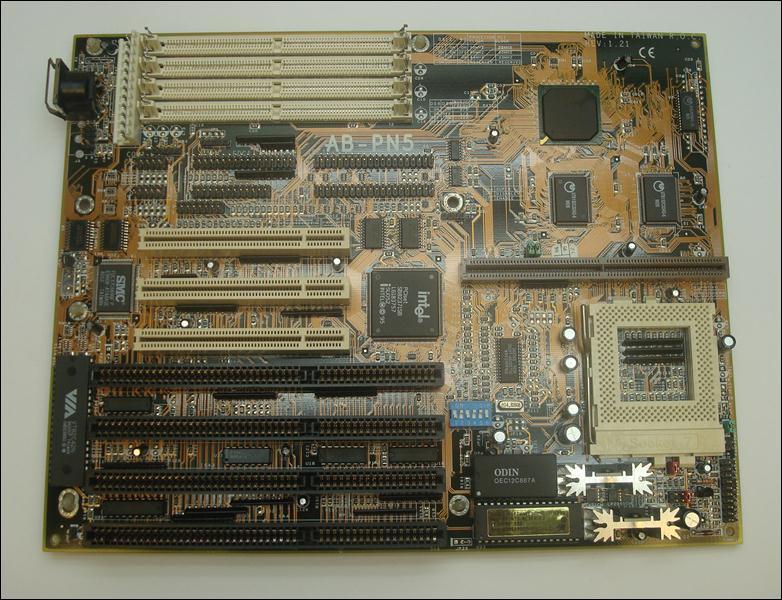
Year: 1996
Type: Socket 7
Form Factor: AT
Chipset: Intel 430HX (Triton II)
Slots: 4 x ISA (16-bit), 3 x PCI
Memory: 4 x 72-pin SIMMs (FPM or EDO, 256 MB max.)
BIOS: Award v4.51PG
BIOS Dates: 04/17/96, 08/19/96, 10/04/96, 12/30/96, 04/09/97, 05/30/97, 07/21/97, 08/22/97, 11/17/97 and 01/21/98
Known Board Revisions: 1.2
, 1.21, 1.4
FCC ID: I4BAB-PN5
Supports Intel P54C from 75 MHz up to 200 MHz, and P55C (Pentium MMX) CPUs at 166 or 200 MHz. From AMD it supports the 5k86-Pxxx (any speed) and from Cyrix the 5x86 ((DX[2], DX2-V50, DX2-V66, DX2-V80, and DX4-100), 6x86 and 6x86L CPUs from P120+ up to P166+, with front side bus speed settings of 50 MHz, 60 MHz and 66 MHz.
CPU core voltages can be set to 2.5, 2.7, 2.8, 2.9, 3.38 and 3.52V.
It has a COAST slot for L2 cache expansion beyond the 256 KB that is already on the mainboard, supporting a further 256 KB to make 512 KB L2 cache in total.
The board came with 2 serial ports, 1 parallel port, a floppy controller, 2 EIDE hard disk controllers, and an infra-red port.
User Manual |
AB-PR5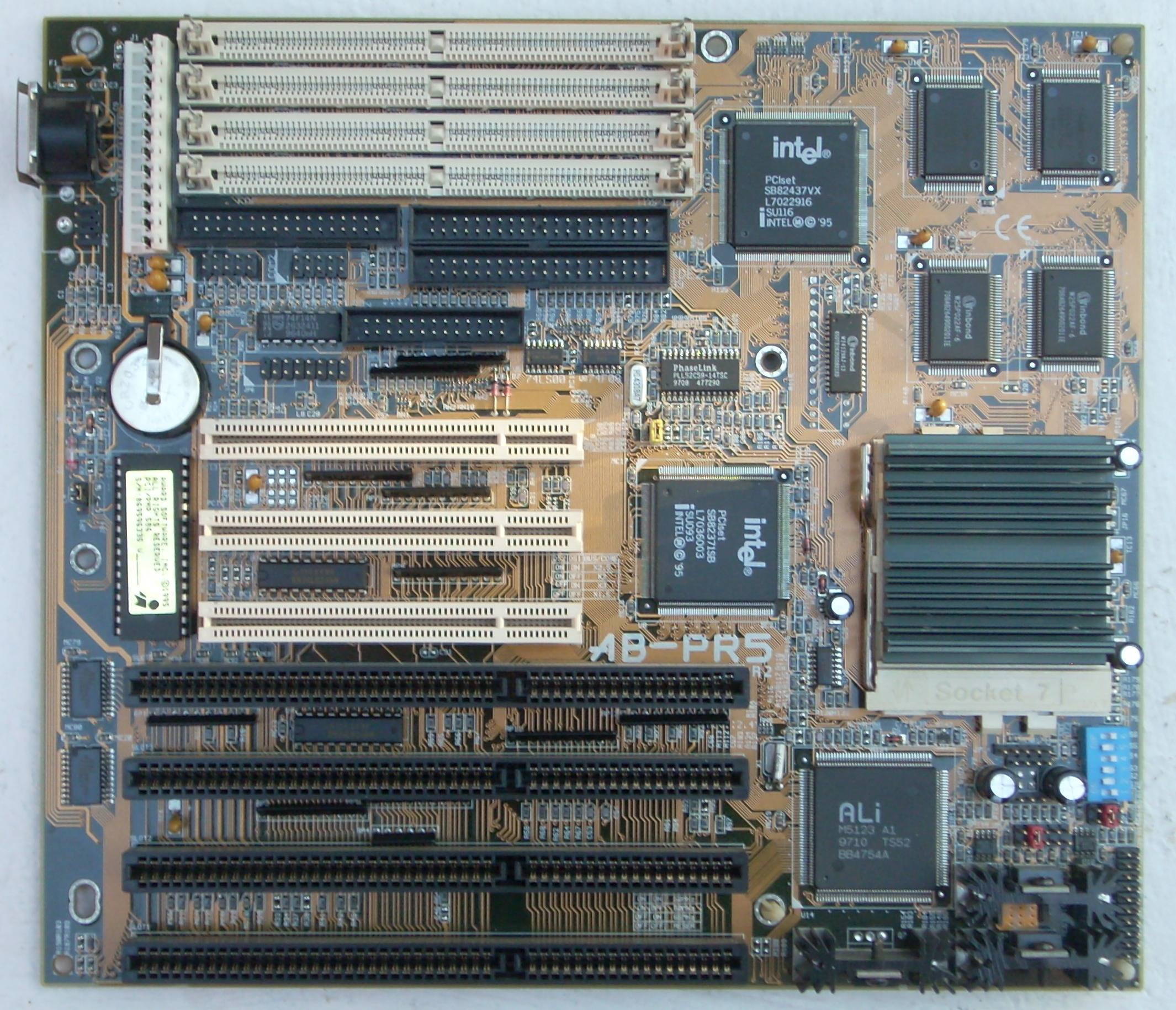
Year: 1995?
Type: Socket 7
Form Factor: AT
Chipset: Intel 430VX
Known Revisions: v1.1
BIOS: Award
BIOS Dates: 04/30/96
Supports Cyrix 6x86 P120+ to P166+ CPUs on BIOS dated 04/30/96, but require the 10A voltage regulator.
|
AB-PT5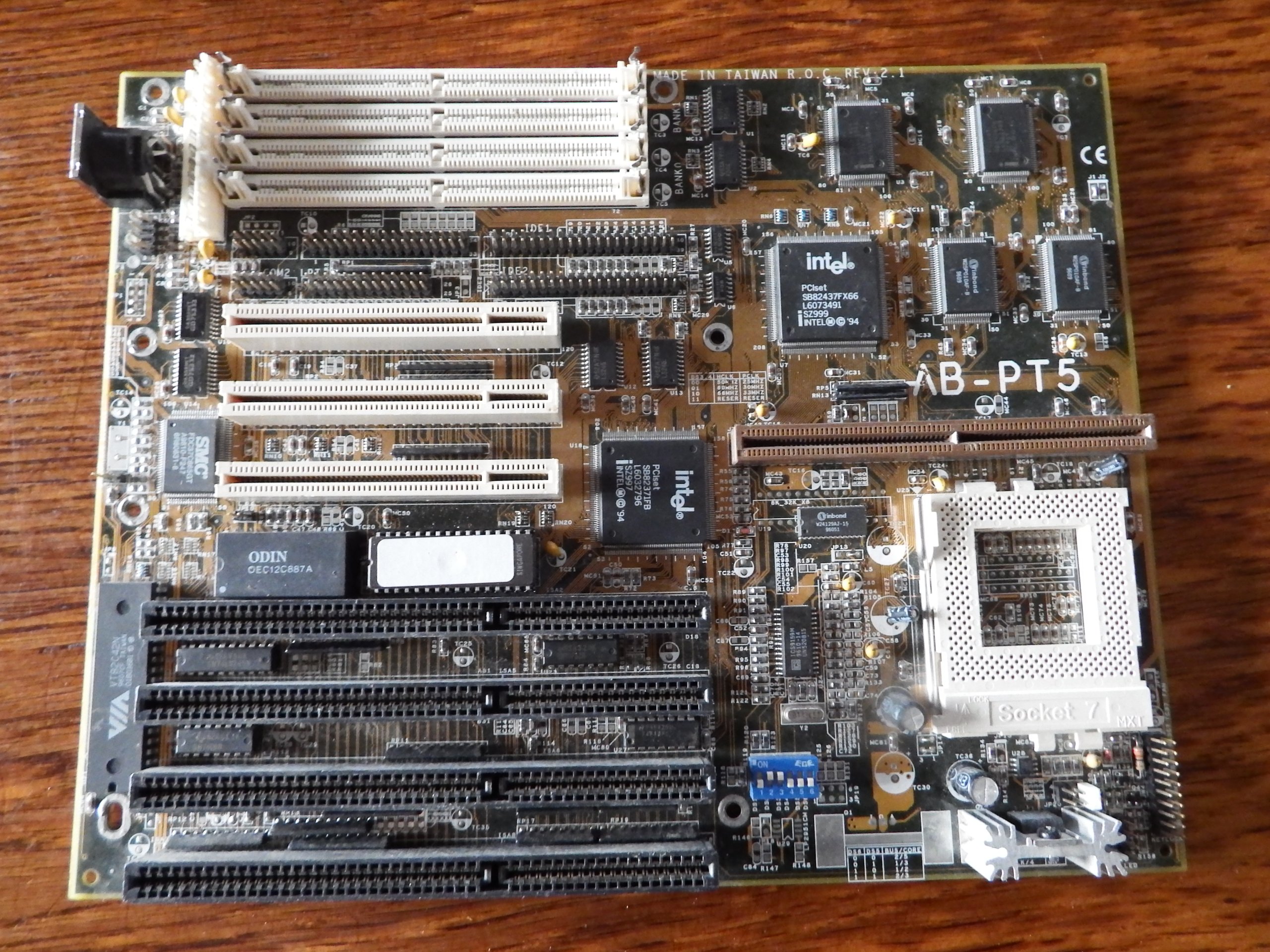
Year: 1995?
Type: Socket 7
Form Factor: AT
Power Connector: AT
Chipset: Intel 430FX
Known Revisions: v1.0, v2.11
BIOS: Microid Research MR BIOS v3.46
BIOS Dates: 02/02/96
Supports Cyrix 6x86 P133+ and P166+ CPUs on BIOS dated 02/02/96, but require the 10A voltage regulator.
|
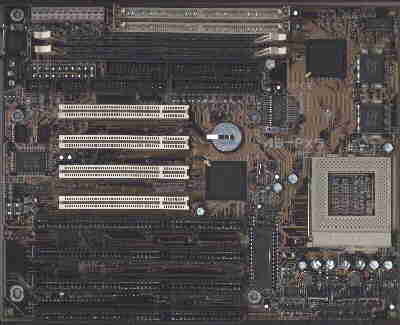 AB-PX5 AB-PX5
Year: 1997
Type: Socket 7
Form Factor: Baby AT
Power Connector(s): AT
Chipset: Intel 430TX
Slots: ISA (4), PCI (4)
Memory: 2 x SIMM, 2 x DIMM.
BIOS: Award
Known Revisions:
1.14c.
Comes with 512KB L2 cache onboard. Bus frequencies from 50 to 83 MHz. CPU core voltage support is 3.2V, 2.9V, 2.8V and 2.5V.
From Tom's Hardware review:
"This board seems to support 75 and 83 MHz bus clock, but I had some trouble with it, even with our latest revision 1.14c. This expressed in hangups and protection errors under Windows 95 as well as blue screens under Windows NT. Particularly the old Corsair memory didn’t want to work properly over 66 MHz. In spite of these problems, performance is not bad at all and the overall results at 66 MHz are satisfactory. Except with the 6x86MX, the board is slower under Windows NT. Maybe a new BIOS can bring the estimated stability at 83 MHz bus."
|
AB-SM5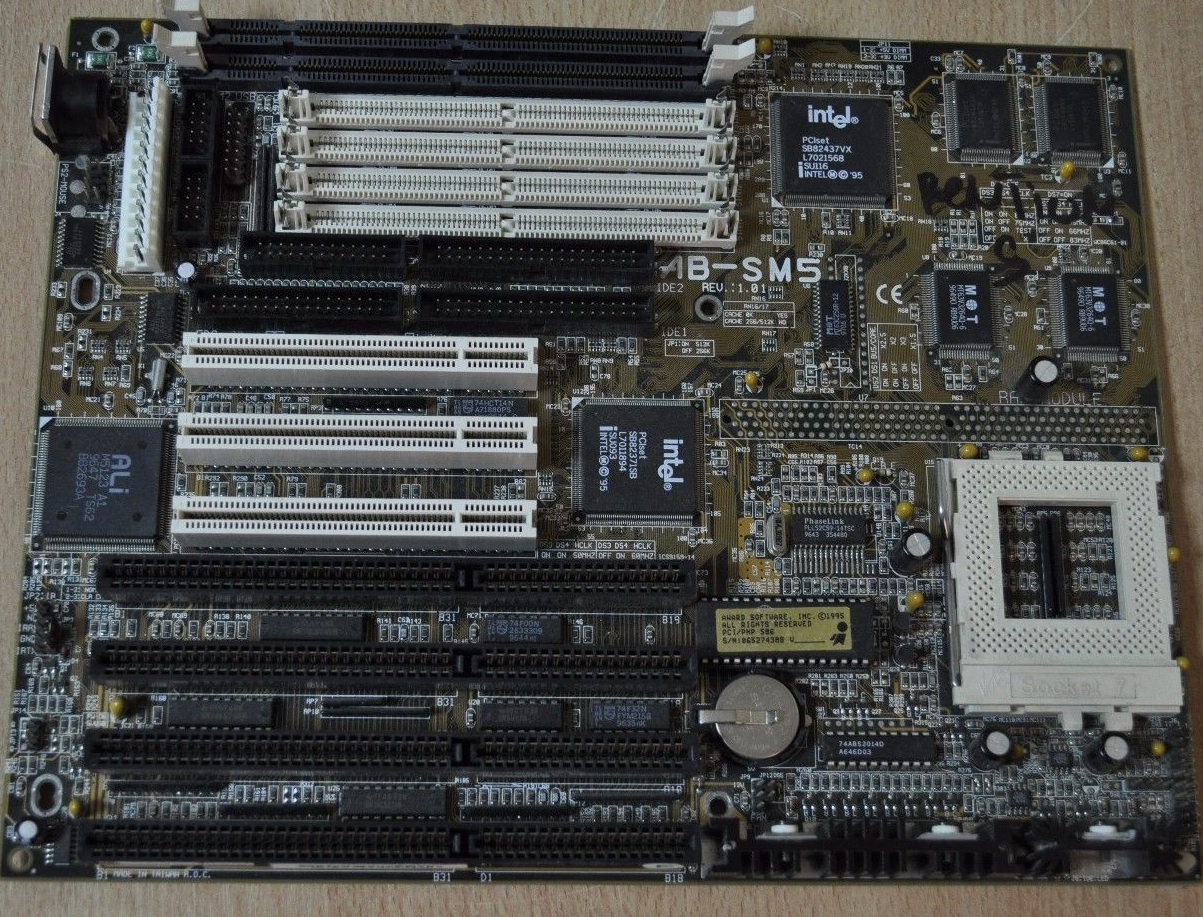
Year: ?
Type: Socket 7
Form Factor: ATX
Chipset: Intel 430VX
Slots: ISA (4 x 16-bit), PCI (3)
Memory: 4 x 72-pin SIMM (2 banks), 2 x 168-pin DIMM.
BIOS: Award 4.51PG
Known Revisions: 1.01
|
AB-TX5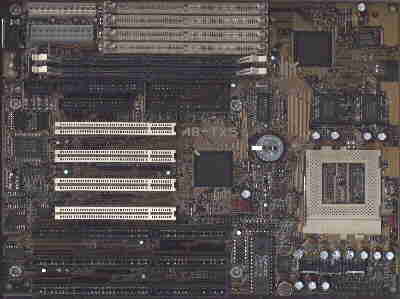
Year: 1997
Type: Socket 7
Form Factor: AT (280mm x 220mm)
Power Connector(s): AT and ATX
Chipset: Intel 430TX
Slots: ISA (3), PCI (4)
Memory: 4 x SIMM, 2 x DIMM.
BIOS: Award
Known Revisions:
1.0.
Bus frequencies: 50 - 83 MHz.
Core voltages: 3.2V, 2.9V, 2.8V, 2.7V and 2.5V.
Clock multipliers: 1.5x - 3.5x.
From Tom's Hardware review:
"ABit's newest TX chipset board, the AB-TX5, seems to inherit the crown of the AT boards most suited for overclockers and speed fans: It's fast, faster and the fastest. Featuring 'Soft Menu', it's very easy to adjust CPU clock ratio. External frequencies are supported up to 83 MHz, very stable by the way. Even the Pentium 233 MMX ran fine at 291 MHz and 3.2 Volts! It's good to see that the performance of the AB-PX5 was improved much more as well. This is my personal favorite TX board by the way. A new board must first be reliable and stable for me under all circumstances. And if it's fast, too, I got my candidate. ABit's TX5 board fits exactly my personal expectations. Please don't forget that there are more fine boards as well; before you make your choice, go ahead and read some other reviews as well. Maybe you will find some fact or feature you will regard even more important than I do."
"This motherboard is fast. It achieved the highest scores in all three game tests (Quake II, Turok, and Incoming). It just oozes quality and certainly showcases Abit's talents in motherboard design. They have thought of everything. The ability to clock the system bus at up to 83.3 MHz through the BIOS is certainly a boon for overclockers. I still can't bring myself to give this motherboard a Hot Hardware Award - even though it is the fastest Socket 7 motherboard in our tests. This award has to go to one of the new breed of Super 7 boards.
Mainboard Design: 93
Speed: 97
Features: 92
Overclockability: 95
OVERALL: 94.25"
PC PowerPlay, July 1998
|
 Universal Abit
Universal Abit












